Stand-Out Designs for Stand-Alone Containers: Part 1
These stunning pots can do more than flank a doorway

Give typical homeowners a pot, and they will likely plant it up and place it near one of the entries to the home. But stand-alone containers can make dramatic impressions in a variety of spaces. Bowls or boxes in the corners of patios look great when planted with interesting succulents or mixed annuals. Pots can also be placed on outdoor coffee tables as conversation pieces. The center of a courtyard is always a great place for a tall planter that generates interest for pedestrians walking by. Window boxes are an easy way to brighten up the views from indoor spaces and frame uninspiring windows. As you can see, there are few places where a single container doesn’t make a positive impact.
Simple pots support lavish plantings
A simple container allows its plants to do the talking. Brimming with color, this modern pot lets the many shapes and textures of the plants, from the papyrus to the aeonium to the New Zealand flax, stand out.
- King Tut® papyrus (Cyperus papyrus ‘King Tut’, USDA Hardiness Zone 11)
- Flowering maple (Abutilon cv., Zones 8–11)
- ‘Zwartkop’ aeonium (Aeonium arboreum ‘Zwartkop’, Zones 9–11)
- Sweet potato vine (Ipomoea batatas cv., Zone 11)
- Coleus (Solenostemon scutellarioides cvs., Zones 12–13)
- Superbells® Coralberry Punch calibrachoa (Calibrachoa ‘USCAL66501’, annual)
- ‘Wilma’s Gold’ trailing golden rosemary (Rosmarinus officinalis ‘Wilma’s Gold’, Zones 8–11)
- ‘Flamingo’ New Zealand flax (Phormium cookianum ‘Flamingo’, Zones 8–11)
Thrill, fill, and spill

‘Yellow King Humbert’ canna stands as a proud thriller, while the grasses and the coleus add bulk and the bright annuals tumble over the edge of the pot.
- ‘Yellow King Humbert’ canna (Canna ‘Yellow King Humbert’, Zones 8–11)
- ‘Sky Rocket’ fountain grass (Pennisetum setaceum* ‘Sky Rocket’, Zones 10–11)
- Variegated tataki grass (Carex trifida ‘Rekohu Sunrise’, Zones 7–11)
- Supertunia® White petunia (Petunia ‘Kakegawa S30’, annual)
- ‘Goldilocks’ creeping Jenny (Lysimachia nummularia* ‘Goldilocks’, Zones 4–8)
- Snow Princess® alyssum (Lobularia ‘Inlbusnopr’, annual)
- Supertunia® Citrus petunia (Petunia ‘Dancas110’, annual)
- ‘Versa Lime’ coleus (Solenostemon scutellarioides ‘Versa Lime’, Zones 12–13)
- Variegated ground ivy (Glechoma hederacea* ‘Variegata’, Zones 4–9)
Lively hues excite empty spaces
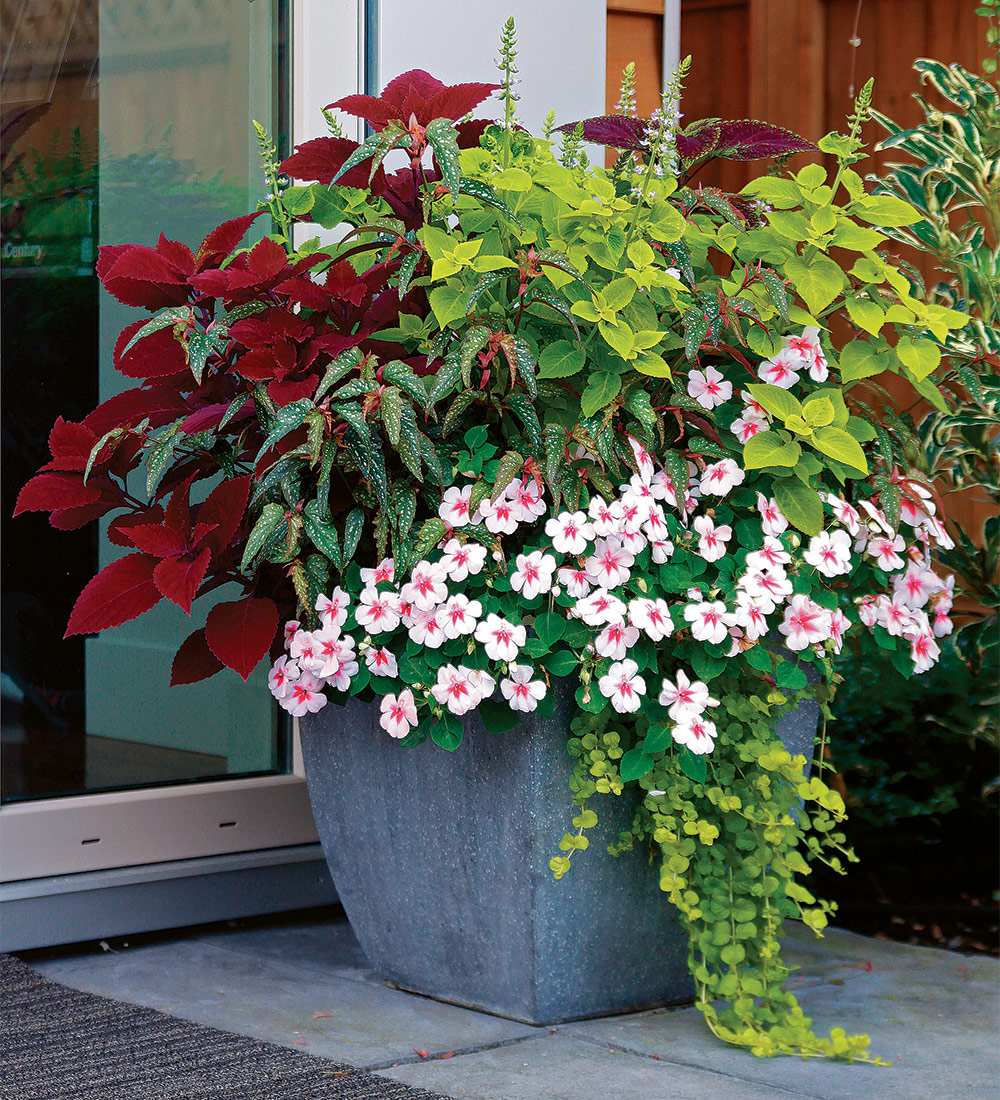
The void outside the stationary side of this door becomes charming with the addition of a bicolor impatiens. A coleus and a creeping Jenny add extra hints of vivacity and bolster the impatiens. You can’t do much with the space right outside a sliding door, but a container can infuse it with interest.
- ‘Versa Lime’ coleus (Solenostemon scutellarioides ‘Versa Lime’, Zones 12–13)
- ‘Big Red Judy’ coleus (Solenostemon scutellarioides ‘Big Red Judy’, Zones 12–13)
- ‘Medora’ begonia (Begonia ‘Medora’, Zones 12–13)
- Super Elfin™ Blush impatiens (Impatiens walleriana Super Elfin™ Blush, annual)
- ‘Goldilocks’ creeping Jenny (Lysimachia nummularia* ‘Goldilocks’, Zones 4–8)
Give them something to see

This pot is a visual break between the lawn and the patio. The pinks, purples, and silvers provide a treat for the eye, instead of just gray wood and green turf.
- Dogfennel (Eupatorium capillifolium, Zones 3–10)
- ‘Happy Single Wink’ dahlia (Dahlia ‘Happy Single Wink’, Zones 9–11)
- ‘Silver King’ mugwort (Artemisia ludoviciana ‘Silver King’, Zones 4–9)
- ‘Religious Radish’ coleus (Solenostemon scutellarioides ‘Religious Radish’, Zones 12–13)
- ‘Flamenco Cha Cha’ cuphea (Cuphea llavea ‘Flamenco Cha Cha’, Zones 9–11)
- Sweet potato vine (Ipomoea batatas cv., Zone 11)
- ‘Silver Falls’ dichondra (Dichondra argentea ‘Silver Falls’, Zones 10–11)
Color makes flowers appear more plentiful

At first glance, there appears to be a ton of pink flowers in this pot. A closer look reveals that there are only two flowering plants: a calibrachoa and a zinnia. The surrounding foliage picks up the pink theme and spreads it throughout the design, making it full of color—without relying completely on flowers.
- Calibrachoa (Calibrachoa cv., annual)
- Curly parsley (Petroselinum crispum ‘Crispum’, Zones 5–9)
- Coleus (Solenostemon scutellarioides cv., Zones 12–13)
- ‘Benary’s Giant’ zinnia (Zinnia elegans ‘Benary’s Giant’, annual)
- Flowering tobacco (Nicotiana alata cv., annual)
- ‘Fireworks’ fountain grass (Pennisetum setaceum* ‘Fireworks’, Zones 8–11)
Designed by Stephanie Fagan for her garden in Newtown, Connecticut
Useful, potted potager
Edible plants can be arranged into pleasing container gardens too. Every bit of this design, from the herbs to the flowers, can make its way from pot to plate. The unfinished wooden container and edible greens would look at home near a kitchen or outdoor grilling area.
- ‘Wilma’s Gold’ trailing golden rosemary (Rosmarinus officinalis ‘Wilma’s Gold’, Zones 8–11)
- Alaska series nasturtium (Tropaeolum majus ‘Alaska Mix’, annual)
- Chives (Allium schoenoprasum, Zones 5–11)
Greens glow in dark spots
The bird of paradise provides a dark green canopy under which a chartreuse creeping Jenny and ‘Versa Lime’ coleus glow. The look becomes magical with the addition of a contrasting impatiens. When planting in shade, it’s easy to choose the most colorful plants available to lighten up the dark, but remember that shades of green look graceful in low-light spots.
- Bird of paradise (Strelitzia alba, Zones 12–13)
- ‘Versa Lime’ coleus (Solenostemon scutellarioides ‘Versa Lime’, Zones 12–13)
- ‘Solar Sunrise’ coleus (Solenostemon scutellarioides ‘Solar Sunrise’, Zones 12–13)
- Riviera Deep Salmon impatiens (Impatiens ‘Dueridesal’, annual)
- ‘Goldilocks’ creeping Jenny (Lysimachia nummularia* ‘Goldilocks’, Zones 4–8)
- Sweet potato vine (Ipomoea batatas cv., Zone 11)
Think of pots like flowers in a vase
You can plant containers as you would arrange flowers. Sometimes you want that traditional up-and-out form. Compact plants, like these begonias and coleus, make a nice tight column from which the rubber plant stretches out.
- ‘Burgundy’ rubber plant (Ficus elastica* ‘Burgundy’, Zone 13)
- ‘Gartenmeister Bonstedt’ fuchsia (Fuchsia ‘Gartenmeister Bonstedt’, Zones 9–10)
- ‘Solenia Orange’ begonia (Begonia ‘Solenia Orange’, Zones 12–13)
- ‘Lava Rose’ coleus (Solenostemon scutellarioides ‘Lava Rose’, Zones 12–13)
- ‘Golden Ingot’ English ivy (Hedera helix* ‘Golden Ingot’, Zones 5–11)
- Fusion Infrared Apricot exotic impatiens (Impatiens ‘Balfusinred’, annual)
- ‘Gryphon’ begonia (Begonia ‘Gryphon’, Zones 12–13)
- Kong™ Salmon Pink coleus (Solenostemon scutellarioides Kong™ Salmon Pink, Zones 12–13)
Set off a blast of color
Basing this planter’s design on so many red plants makes an impressive impact. The diverse shapes let each red plant hold its own, while a creeping Jenny and ‘Lineatum’ New Zealand flax add green verticality to the design.
- ‘Lineatum’ New Zealand flax (Phormium tenax ‘Lineatum’, Zones 8–11)
- ‘Trusty Rusty’ coleus (Solenostemon scutellarioides ‘Trusty Rusty’, Zones 12–13)
- ‘Gartenmeister Bonstedt’ fuchsia (Fuchsia ‘Gartenmeister Bonstedt’, Zones 9–10)
- Flying Colors® Coral twinspur (Diascia ‘Diastis’, Zones 9–10)
- ‘Goldilocks’ creeping Jenny (Lysimachia nummularia* ‘Goldilocks’, Zones 4–8)
A design from the dark side
Who would have thought that so many dark plants could look so good together? Dark purple sweet potato vines, a dahlia, and a canna are arranged around the rim of the pot. The ring is filled with lighter-colored plants, like Bronze Age™ coleus, ‘Pina Colada’ coprosma, and fountain rush. They diffuse the purple-black plants yet keep the colors toned down to the darker end of the spectrum for drama.
- ‘Australia’ canna (Canna ‘Australia’, Zones 8–11)
- Fountain rush (Elegia capensis, Zones 10–11)
- ‘Happy Single Date’ dahlia (Dahlia ‘Happy Single Date’, Zones 9–11)
- ‘Pina Colada’ coprosma (Coprosma repens ‘Pina Colada’, Zones 9–11)
- Eternal Flame™ cuphea (Cuphea ‘Eternal Flame’, Zones 7–10)
- ‘Belinda’s Find’ hook sedge (Uncinia rubra ‘Belinda’s Find’, Zones 8–11)
- ‘Sweet Caroline Sweetheart Purple’ sweet potato vine (Ipomoea batatas ‘Sweet Caroline Sweetheart Purple’, Zone 11)
- Scarlet pimpernel (Anagallis arvensis, Zones 7–10)
- Bronze Age™ coleus (Solenostemon scutellarioides ‘Bronze Age’, Zones 12–13)
- ‘Albury Purple’ St. John’s wort (Hypericum androsaemum ‘Albury Purple’, Zones 5–7)
- ‘Sweet Caroline Purple’ sweet potato vine (Ipomoea batatas ‘Sweet Caroline Purple’, Zone 11)
Balance light and dark plants
This ‘Bloodgood’ Japanese maple is dark and lurks at the rear of the pot. In complete contrast, a bright impatiens and a delta maidenhair fern light up the front for a dynamic experience in brightness.
- ‘Bloodgood’ Japanese maple (Acer palmatum* ‘Bloodgood’, Zones 5–8)
- ‘Fragrans’ delta maidenhair fern (Adiantum raddianum ‘Fragrans’, Zone 11)
- Super Elfin™ Blush impatiens (Impatiens walleriana Super Elfin™ Blush, annual)
- ‘Wojo’s Gem’ vinca vine (Vinca major* ‘Wojo’s Gem’, Zones 7–9)
- Golden trailing spikemoss (Selaginella kraussiana ‘Aurea’, Zones 6–10)
Flower-free geometry
These foliage plants make a sharp, shape-based statement. A boxy container supports a leafy rectangle at its surface, from which three triangles emerge: the juniper upward and the ground ivy downward.
- ‘Moonglow’ Rocky Mountain juniper (Juniperus scopulorum ‘Moonglow’, Zones 3–7)
- ‘Hansel’ rhododendron (Rhododendron ‘Hansel’, Zones 6–9)
- ‘Sweet Caroline Purple’ sweet potato vine (Ipomoea batatas ‘Sweet Caroline Purple’, Zone 11)
- ‘Sweet Caroline Bewitched’ sweet potato vine (Ipomoea batatas ‘Sweet Caroline Bewitched’, Zone 11)
- Sunset Strip™ coleus (Solenostemon scutellarioides ‘Sunset Strip’, Zones 12–13)
- ‘Dipt in Wine’ coleus (Solenostemon scutellarioides ‘Dipt in Wine’, Zones 12–13)
- Variegated ground ivy (Glechoma hederacea* ‘Variegata’, Zones 4–9)
- Spitfire™ coleus (Solenostemon scutellarioides ‘Spitfire’, Zones 12–13)
Hot colors are transformative
Reds, oranges, and even ocher yellows can enliven a whitewashed window box. Just be sure to balance them with cooler colors. This bright begonia needs a dark anchor; that’s how the rubber plant earns its keep. Hot colors are like a tango: Used well, they’re a saucy source of interest; used incorrectly, they’re garish and stand out harshly.
- ‘Burgundy’ rubber plant (Ficus elastica* ‘Burgundy’, Zone 13)
- ‘Solenia Orange’ begonia (Begonia ‘Solenia Orange’, Zones 12–13)
- English ivy (Hedera helix* cv., Zones 5–11)
*These plants are considered invasive in some areas. Please check invasiveplantatlas.org or your state’s list of invasive plants for more information.
—Todd Holloway is the owner of Pot Inc., a plant design firm, and creates premium landscape and garden planters in Vancouver, British Columbia.
Photos, except where noted: Joshua McCullough/phytophoto.com
To see more inspiring stand alone container designs, check out Part 2!







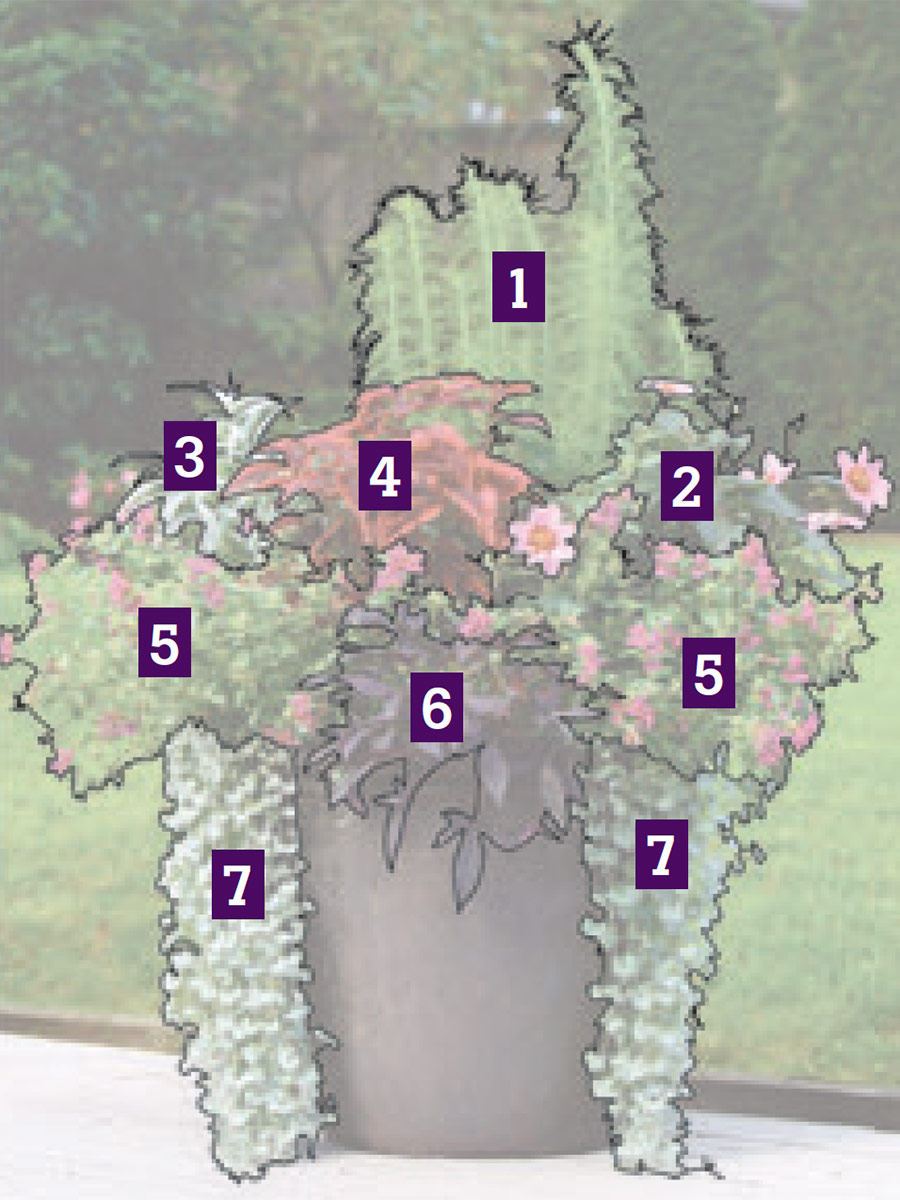





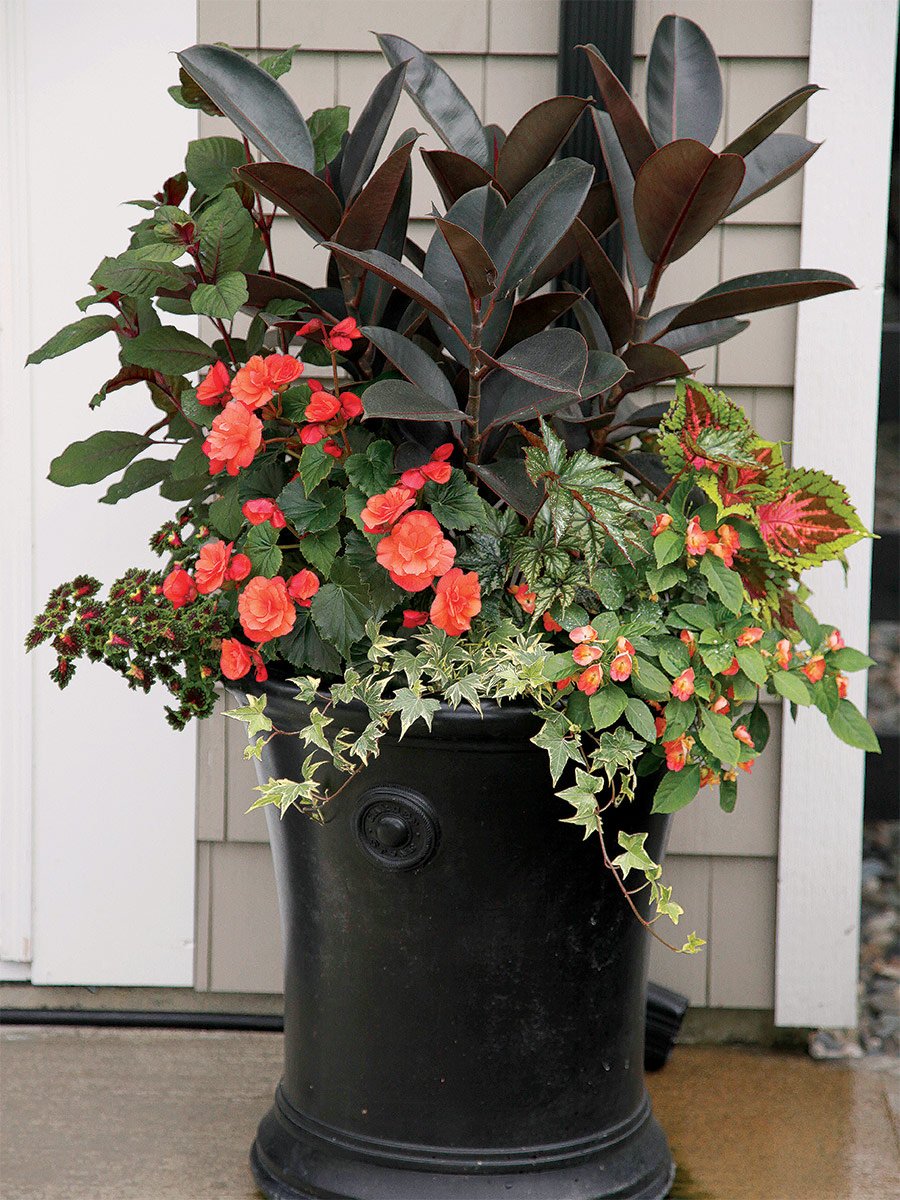




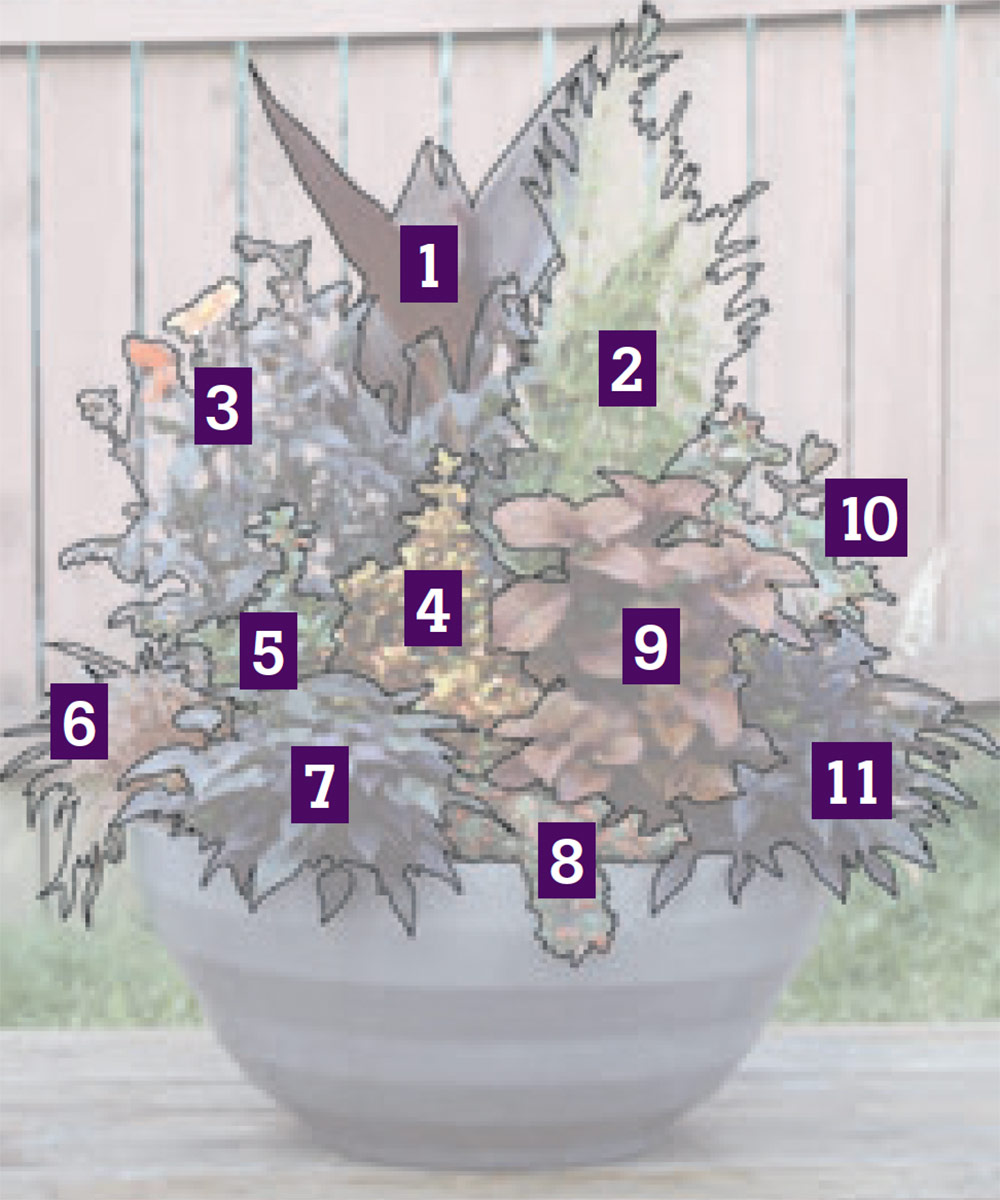

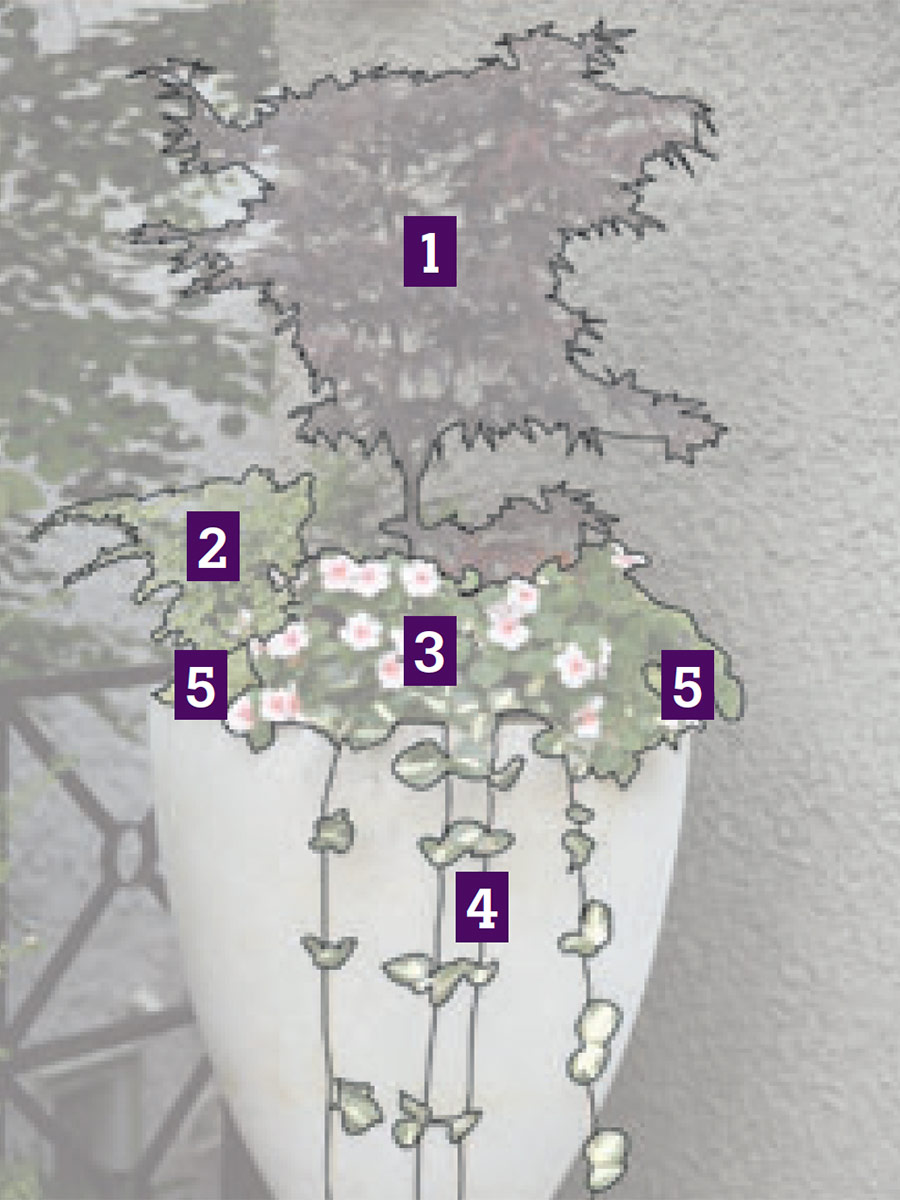







Comments
Log in or create an account to post a comment.
Sign up Log in